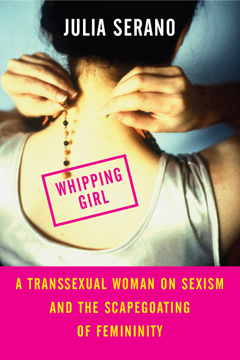Stuff that influenced me!
While my friends and I back in the early-mid 2010s largely found the work of trans women who came up in the 1990s and early 2000s hard to relate to for many reasons, the publication of Whipping Girl by Julia Serano in 2007 ushered in an era of transfeminist work and thought that I found much more compelling. Here’s a few sources that I came across early in my transition that made me the woman I am today. If you’re curious what my corner of the landscape was like and how we thought about ourselves between then and ~2019, these are all great sources.

Above: the location of the entry plug in most trans women
Before going any further, and I can’t stress this enough, read Whipping Girl immediately! Serano set the tone for the rest of the works I’m mentioning here in a big way, as well as the tone of 2010s transfem communities generally. The book adeptly locates our place in the gender politics of academia, psychiatry, and mass media, establishes in great detail the forms prejudice against trans women tends to take and what motivates it, and sketches a framework for feminist thought growing out from that analysis.
Some aspects of the book are slightly dated in the modern era, for instance, she often uses the term “transsexual” which many find offputting for various reasons today, and she talks at length about media institutions like reality TV and Jerry Springer-like programming, both of which have largely lost their cultural influence to various aspects of the social media landscape.
However, so much of what Serano wrote holds up fairly well, if it isn’t actively predictive of the situation we find ourselves in today. Much of what she had to say about queer/trans activist and academic circles in the 2000s has bled into online attitudes and discourses around transfemininity in the 2020s, the regressive feminist tendencies she places herself in opposition to became major media and political forces, discussions of the sexualization of transfemininity have never been more relevant, and transmisogyny is the same as it ever was.
Serano has also published numerous other books. As of writing, her most recent is Sexed Up in 2022, an analysis of how sexualization and stigmatization works across various marginalized demographics, and where it comes from. She also has various blogs that she’s maintained over the years, and several other side projects. You can find links to them all from her homepage here:

Below are some other figures and works that helped me find my place in the world:
Zinnia Jones and GenderAnalysis – Jones is an outspoken trans feminist and atheist whose youtube channel caught my attention right when I was starting to grow into both identities. Her youtube series Gender Analysis covers many of the scientific and social aspects of transition, and articulates many frustrations trans women often have with such things. She and partner in crime Heather McNamara currently run a website by the same name that features blog posts about theory and current events.

Natalie Reed – Reed is another atheist/skeptic-aligned transfeminist who wrote for Skepchick, Queereka (seemingly now defunct), and Freethoughtsblog extensively in the early 2010s. Of particular note is her 2012 essay “The Null HypotheCis,” which outlines some of the ways people tend to overthink the question of whether transition is right to them and how to push past that. This article popped up in basically every “Am I Trans?” thread on reddit for several years after it was published, and has been cited by many as being a nudge that pushed them over the edge.

Imogen Binnie’s Nevada – The definitive transfem novel, as far as I’m concerned. Binnie captures a snapshot of transfem internality in a way that few, if any, other works really manage to do. Maria and James feel entirely plausible as members of the communities I’ve passed through, in all their neurotic, often self-effacing glory. The oftentimes oddly paced and constructed narrative voice is itself iconic and in many ways inseparable from how I see us all now. Stellar work.
Liz Sandifer’s Neoreaction: A Basilisk – This collection of essays published in 2015 traces the links between a handful of online radical right wing thinkers in the 2000s and in the 20th century to the philosophies that won conservatives the 2016 and 2024 elections. In my opinion, the title essay is mandatory reading to truly understand how we got here. It’s a lurid and genuinely nauseating dive into the apocalyptic ideology motivating modern conservatism that seeks to put a finger on exactly what it is about xenophobia and transmisogyny that motivates fascists the way they do. Bioterrorist, infect thyself.
I suppose in general, the brief intersection of transfeminist and atheist/”skeptical” thought really made both fields more accessible to me. Especially early on, I appreciated the practical, nuts and bolts discussion of gender and discrimination, often contextualized within scientific research, because that’s always been how my brain likes to reason. It did a lot to demystify what I was going through, and it felt reassuring that people who thought similarly to me were in the same boat, as for quite a while I had a hard time identifying with the more wiggly discussions of queer topics I’d encountered up to that point. Unfortunately, skepticism as a philosophy became deeply reactionary around the same time, and this space mostly dissipated or became parts of the youtube political commentary space instead.

